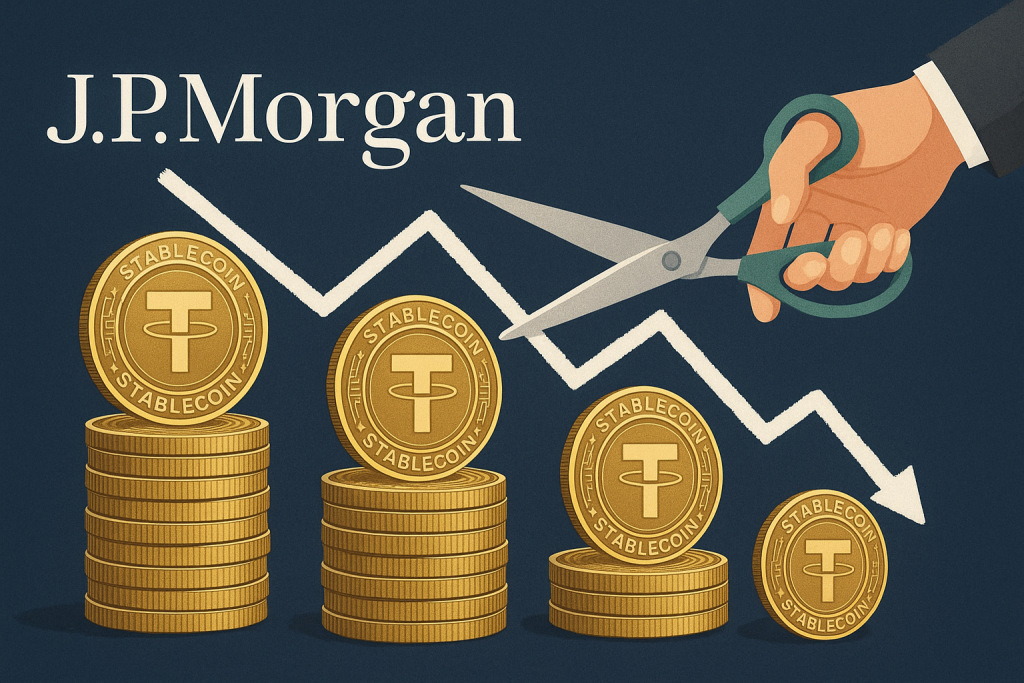Introduction
The cryptocurrency ecosystem has witnessed a whirlwind of speculation, innovation, and policy debates over the past decade, particularly surrounding stablecoins—cryptocurrencies designed to maintain a stable value against a reference currency, often the U.S. dollar. While early projections painted a booming trajectory for stablecoin adoption, a new sobering analysis from J.P. Morgan has thrown cold water on the idea of trillion-dollar growth. On July 3, 2025, J.P. Morgan downgraded its stablecoin market outlook, projecting a $500 billion valuation by 2028, slashing previously touted trillion-dollar expectations in half.
This revised forecast has rippled through the crypto, fintech, and investment communities, challenging assumptions about the speed and scale of stablecoin integration into mainstream finance. Despite earlier predictions from industry players such as Standard Chartered and Bernstein, which anticipated growth to $2 trillion and even $4 trillion respectively, J.P. Morgan’s outlook is grounded in current market realities: limited payment adoption, regulatory fragmentation, and concentration of use in trading-related activities.
Stablecoins: From Speculative Tools To Aspirational Financial Rails
Initially created to offer a “stable” alternative to volatile cryptocurrencies like Bitcoin or Ethereum, stablecoins emerged as a core pillar in the decentralized finance (DeFi) ecosystem. Pegged to fiat currencies like the U.S. dollar, the most prominent stablecoins—USDT (Tether), USDC (Circle), and DAI (MakerDAO)—serve purposes ranging from hedging volatility to facilitating liquidity and trading pairs on crypto exchanges.
Over the years, their appeal extended beyond trading, as fintech firms, payment apps, and even banks began exploring stablecoins as fast, borderless settlement tools. This piqued investor interest, especially in emerging markets where traditional banking is costly or inaccessible. The narrative shifted: stablecoins could become the backbone of next-gen digital payments, disrupting everything from remittances to interbank clearing systems.
But as J.P. Morgan’s latest research reveals, this narrative hasn’t played out as expected—at least not yet.
The 2025 Reality Check: J.P. Morgan’s Conservative Forecast
According to the report, J.P. Morgan Investment Management Inc. estimates the current stablecoin market at approximately $250 billion, with just 6%—about $15 billion—attributed to payment usage. The vast majority of demand still stems from speculative applications: crypto trading, DeFi, and as collateral on digital lending platforms.
The firm’s new projection of $500 billion by 2028 reflects a more restrained view of growth, particularly in light of limited real-world usage. In contrast, Standard Chartered’s $2 trillion forecast and Bernstein’s $4 trillion supply prediction over the next decade appear overly optimistic given the present adoption rate.
J.P. Morgan asserts that “the idea that stablecoins will replace traditional money for everyday use is still far from reality.” This conclusion resonates with analysts who argue that while stablecoins offer technical advantages, regulatory ambiguity, consumer distrust, and fragmented financial infrastructures stand in the way of meaningful expansion.
Regulatory Clarity Still Lacking Despite The GENIUS Act
One of the key catalysts for stablecoin optimism has been the legislative momentum behind the GENIUS Act—a recently passed U.S. Senate bill aimed at creating a regulatory framework for stablecoins. The act is seen by many as a foundational step toward legitimizing stablecoins within the financial system, potentially unlocking broader institutional participation and public usage.
However, despite this legislative progress, J.P. Morgan highlights that regulatory fragmentation across borders, inconsistent definitions, and slow-moving compliance standards continue to weigh down the sector’s evolution. While the GENIUS Act may provide a domestic roadmap, it is not a silver bullet for global adoption.
In Europe, MiCA (Markets in Crypto Assets Regulation) is set to govern stablecoin issuance and operation across the EU bloc, but rollout challenges remain. In Asia, the picture is even more mixed. While Hong Kong and Singapore have opened regulatory sandboxes for digital assets, mainland China has doubled down on sovereign digital currency over private stablecoin development.
The Shadow Of Central Bank Digital Currencies (CBDCs)
One of the most significant impediments to stablecoin growth is the rise of central bank digital currencies, or CBDCs. More than 130 countries are currently exploring CBDCs, and several—including China, India, and Nigeria—have launched pilot programs or full-scale implementations.
China’s e-CNY (digital yuan) leads the global CBDC race. In June 2025, the People’s Bank of China announced an initiative to expand the e-CNY’s international use, emphasizing cross-border transactions and integration with regional payment systems. Although impressive in scope, J.P. Morgan argues that the success of digital sovereign currencies like e-CNY should not be seen as indicative of stablecoin viability. Unlike stablecoins, CBDCs benefit from state backing, legal tender status, and national infrastructure.
Further complicating matters, Ant Group, a major Alibaba affiliate, revealed plans to apply for a stablecoin issuance license through its overseas arm Ant International. This move would leverage its existing mobile payment behemoth Alipay, yet the success of WeChat Pay and Alipay, according to J.P. Morgan, is also not a replicable template for global stablecoin deployment.
Why Payments Still Elude Stablecoins?
Perhaps The Most Surprising Insight From J.P. Morgan’s Report Is The Persistently Low Usage Of Stablecoins For Payments, Despite Being Their Most Touted Use Case. According To Their Data, Just 6% Of Stablecoin Demand Comes From Payments, A Statistic That Lays Bare The Disconnect Between Innovation And Utility.
A Key Barrier Remains Consumer Trust And Interface Familiarity. Users In Developed Economies Are Still More Comfortable With Debit Cards, Credit Cards, And Digital Wallets Linked To Banks. For Merchants, The Lack Of Point-Of-Sale Infrastructure, Integration Complexities, And Price Volatility Risk—Even With Stablecoins—Deter Adoption.
Moreover, Transaction Fees And Network Congestion On Blockchains Like Ethereum have often made small payments unfeasible. Although Layer 2 scaling solutions and alternative blockchains (Solana, Avalanche, Polygon) offer lower-cost alternatives, their integration into mainstream retail systems remains limited.
Institutional Demand And DeFi Dominance
Despite sluggish payment growth, institutional interest in stablecoins is rising, especially for on-chain settlement, yield strategies, and liquidity provisioning. Major asset managers, hedge funds, and digital custodians are already experimenting with stablecoin-based instruments to bypass traditional rails.
DeFi protocols heavily rely on stablecoins as collateral and liquidity buffers. The ability to mint, lend, and farm using assets like USDC or DAI is foundational to the yield-generation flywheel of decentralized finance. For these applications, the size of the stablecoin market remains critical—but such usage does not equate to retail or public adoption.
This concentration in speculative use cases is precisely why J.P. Morgan tempers its long-term expectations. Unless stablecoins can transition from DeFi tools to real-world enablers, their broader potential will remain untapped.
Competing Visions: Stablecoins Vs. Tokenized Deposits
Another factor weighing on stablecoin prospects is the emergence of tokenized bank deposits. Unlike stablecoins issued by private companies, tokenized deposits are digital representations of commercial bank liabilities—essentially fiat money on-chain.
Institutions like J.P. Morgan (through JPM Coin) and Citigroup are actively developing tokenized deposit systems for interbank clearing, corporate treasury, and cross-border settlements. These assets offer the programmability of stablecoins but with stronger regulatory compliance, known issuers, and embedded banking protections.
For regulators and enterprises, tokenized deposits represent a “safer” alternative to stablecoins, especially in light of controversies involving Tether’s reserves and USDC’s bank exposure during the 2023 SVB crisis. This trend may further divert energy and capital away from open-market stablecoin initiatives.
Stablecoin 2.0: The Path Forward
Despite headwinds, the stablecoin sector isn’t dead. What’s more likely is a reinvention of the stablecoin model—what some refer to as Stablecoin 2.0. Future iterations will likely focus on:
- Full-reserve transparency and audits.
- Bank partnerships for issuance and custody.
- Cross-chain interoperability.
- Integration with traditional payment apps and POS systems.
With big tech entrants, central banks collaborating with fintechs, and new legal frameworks, stablecoins might evolve into institutional-grade instruments. However, their growth will be slower, more controlled, and segmented, as J.P. Morgan now anticipates.
Conclusion
J.P. Morgan’s halving of its stablecoin forecast serves as a sobering reminder that in finance, utility trumps hype. While the dream of a trillion-dollar stablecoin economy captured the imagination of crypto evangelists and futurists, real-world adoption requires more than speculation. It demands trust, utility, regulation, and above all—patience.
The future of stablecoins lies not in displacing fiat currencies, but in augmenting financial infrastructure where traditional systems fall short. Whether as programmable money for institutions, liquidity engines for DeFi, or as digital dollars in emerging markets, their path to $500 billion—though slower than expected—is still a milestone worth watching.



